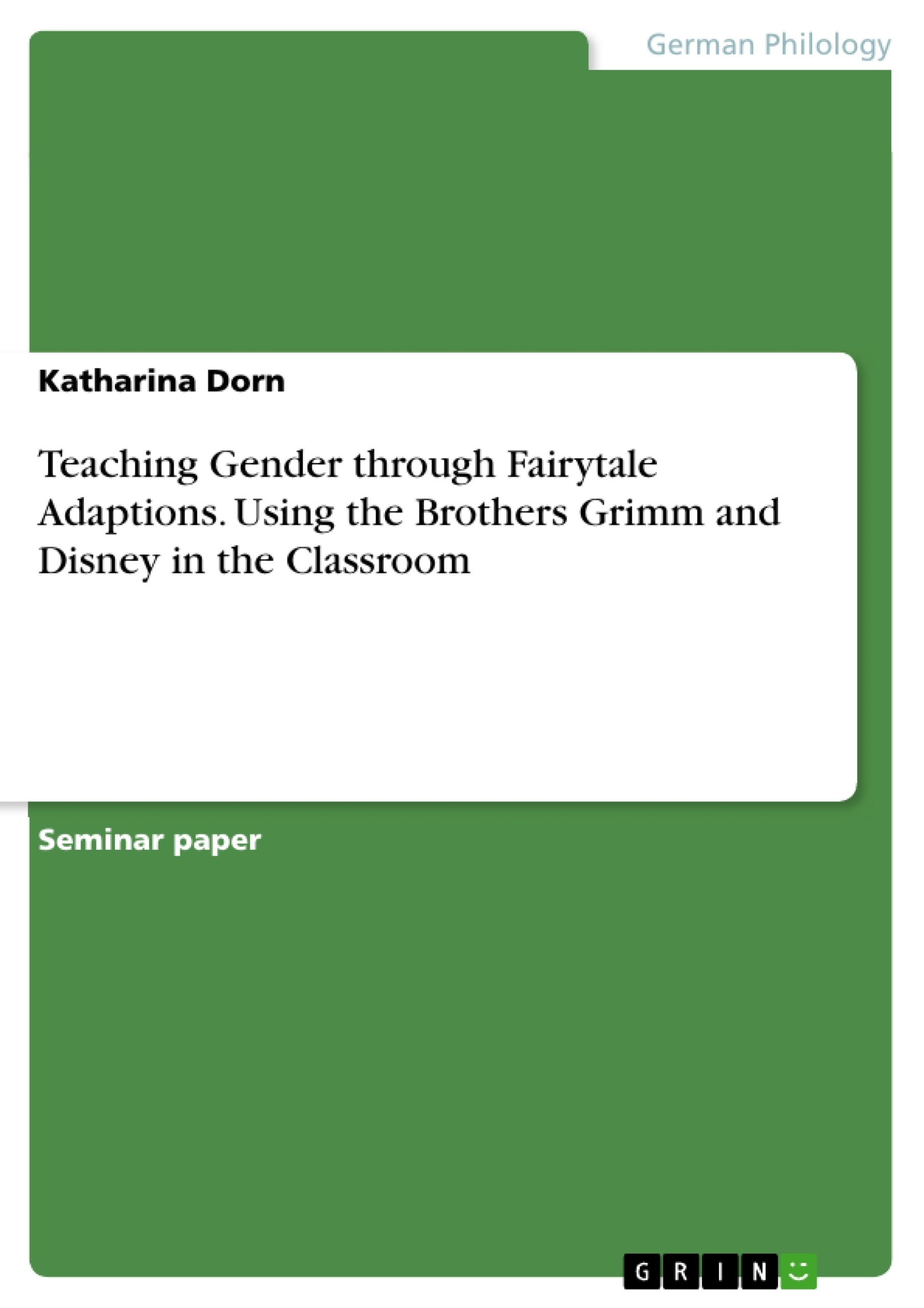Are princesses still living happily ever after or did they change? This paper seeks out to answer this question by a taking a look at fairy tales and their Disney movie adaptions. It will be argued that a comparison of Disney films and traditional fairytales offers a great possibility to teach gender. The goal of this paper is, therefore, to enhance the understanding of older and newer storytelling concerning gender and its benefits for teaching English as a foreign language.
Listening to marvelous tales and stories is and has always been omnipresent in children’s life. Everyone knows the Brothers Grimm and Disney who are popular for their fantastic stories. These stories have been patterns for many Disney movies that have become omnipresent and essential in todays media. Especially Disney is very popular among young students. It is obvious that children are likely to identify with these stories. Consequently, it is important to analyze views and values that are presented in these newer films in comparison to older and more traditional Grimm fairytales.
The first part of this paper offers a description of gender roles and depictions in Grimm and Disney in order to promote the understanding of the two genres. Moreover, there will be a focus on the development of Disney's gender depiction because of the obvious change in their portrayal of female characters. In the second part, then, these theoretical ideas and background information are applied to two concrete stories by Grimm and Disney. Firstly, the fairytale "Der Froschkönig oder der eiserne Heinrich" will be analyzed concerning its depiction of gender. Secondly, Disney’s adapted film "The Princess and the Frog" will also be analyzed according to its depiction of gender and the change that has been made since Grimm's story. The third part deals with the concrete benefits of teaching gender through these two stories. This chapter will also focus on the teaching potential of these Disney films and the learning outcome. To sum up, the third part of this work illustrates the potential that a comparison of Grimms' and Disney’s depiction of gender offers.
Table of Contents
- 1. INTRODUCTION
- 2. DEVELOPMENT OF GENDER IN GRIMM AND DISNEY
- 2.1 PRINCESSES AND FARMERS GIRLS - GENDER IN GRIMM'S FAIRYTALES
- 2.2 WICKED WITCHES AND SLEEPING BEAUTIES - GENDER IN DISNEY
- 3. BRINGING TOGETHER GRIMM AND DISNEY – CONCRETE ANALYSIS OF GENDER
- 3.1 DER FROSCHKÖNIG HOW THE STORY HAS BEEN TOLD ORIGINALLY
- 3.2 THE PRINCESS AND THE FROG – HOW THE STORY IS BEING TOLD TODAY
- 4. BENEFIT OF TEACHING GENDER THROUGH FAIRYTALE ADAPTIONS LIKE DISNEY'S THE PRINCESS AND THE FROG
- 5. CONCLUSION
Objectives and Key Themes
This work analyzes the depiction of gender in classic Grimm fairytales and their modern adaptations by Disney, focusing on how these stories can be used to teach gender in the EFLC classroom. It explores the evolution of gender representation in both forms of storytelling and examines the implications of these changes on young audiences.
- Gender roles and expectations in traditional Grimm fairytales
- The shift in gender representation in Disney adaptations
- The impact of both traditional and modern fairytales on children's understanding of gender
- The potential of using these fairytales as teaching tools in the EFLC
- A comparison of the depiction of gender in "Der Froschkönig" and Disney's "The Princess and the Frog"
Chapter Summaries
The first chapter introduces the research topic, highlighting the significance of fairytales, particularly those by the Brothers Grimm and Disney, in shaping children's understanding of gender roles. It emphasizes the importance of analyzing the evolving representations of gender in these stories, considering their potential influence on young viewers.
The second chapter examines the depiction of gender in Grimm's fairytales, exploring traditional female roles and expectations within these narratives. It categorizes these roles, including those of princesses, farmers' girls, and suffering but hard-working girls, illustrating how they contribute to a prevalent societal understanding of gender.
The third chapter focuses on Disney's adaptations of Grimm's fairytales, analyzing how their portrayal of gender has changed over time. It examines how Disney's approach to gender representation reflects contemporary societal norms and how these adaptations might influence children's perceptions.
The fourth chapter delves into the pedagogical potential of using both Grimm's fairytales and their Disney adaptations as tools for teaching gender in the EFLC classroom. It explores how these narratives can foster critical analysis and understanding of gender roles and their evolution in modern society.
Keywords
The key terms in this study include gender representation, fairytale adaptations, Grimm's fairytales, Disney films, EFLC (English as a Foreign Language Classroom), gender roles, and female characters. The study focuses on analyzing the evolution of gender roles in these narratives and exploring their pedagogical value for teaching gender in language learning contexts.
- Arbeit zitieren
- Katharina Dorn (Autor:in), 2017, Teaching Gender through Fairytale Adaptions. Using the Brothers Grimm and Disney in the Classroom, München, GRIN Verlag, https://www.grin.com/document/376038



